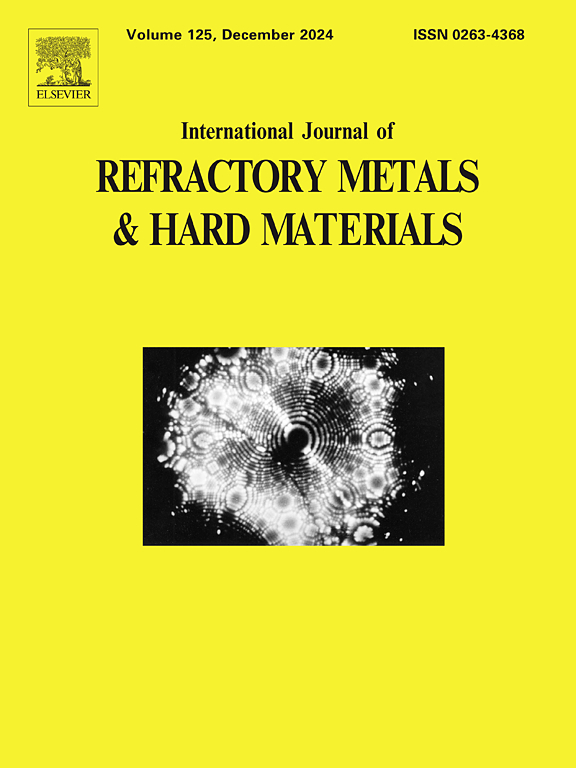Effects of tungsten doping on mechanical properties and tribological behavior of TiB2 coatings in contact with titanium alloy counterballs
IF 4.6
2区 材料科学
Q2 MATERIALS SCIENCE, MULTIDISCIPLINARY
International Journal of Refractory Metals & Hard Materials
Pub Date : 2025-07-14
DOI:10.1016/j.ijrmhm.2025.107331
引用次数: 0
Abstract
Element doping serves as a crucial strategy for surface modification of TiB2 coatings, improving the toughness, mitigating the residual stress and reducing the coefficient of friction of the coatings. Tungsten(W)-doped TiB2 coatings were deposited by magnetron sputtering with adjusting the working current of W target. The chemical compositions, microstructure, mechanical properties and tribological performance of the coatings were systematically investigated using EPMA, SEM, XRD, XPS, TEM, indentation tests and ball-on-disk tribometer. The results reveal that W doping weakens the crystallization of the TiB2 coatings. As the concentration of W increases, the content of TiB2 phase in the coatings decreases and that of WB2 phase increases. However, when the W concentration increases to 15.1 at.%, the content of WB2 in the coatings decreases again. The W element in the coatings mainly exists in the form of amorphous WB2 phase. The 10.7 at.% W-doped TiB2 coating demonstrates an optimal toughness and a moderate adhesion strength. W doping exhibits no statistically significant improvement in adhesive wear performance of the TiB2 coating at room temperature. However, the W-doped TiB2 coatings exhibit an improved anti-adhesive wear resistance at 600 °C, which is correlated with the presence of amorphous WB2 phase.
钨掺杂对TiB2涂层与钛合金球接触力学性能和摩擦学行为的影响
元素掺杂是TiB2涂层表面改性、提高涂层韧性、减小涂层残余应力、降低涂层摩擦系数的重要手段。采用磁控溅射的方法制备了钨掺杂TiB2涂层,并调节了钨靶的工作电流。采用EPMA、SEM、XRD、XPS、TEM、压痕测试和球盘式摩擦计对涂层的化学成分、微观结构、力学性能和摩擦学性能进行了系统的研究。结果表明,W的掺杂削弱了TiB2涂层的结晶。随着W浓度的增加,涂层中TiB2相的含量减少,WB2相的含量增加。然而,当W浓度增加到15.1 at时。%时,涂层中WB2的含量再次下降。涂层中的W元素主要以无定形WB2相的形式存在。10.7秒。掺w的TiB2涂层具有较好的韧性和中等的附着强度。W掺杂对TiB2涂层在室温下的粘接磨损性能没有统计学上的显著改善。然而,w掺杂的TiB2涂层在600℃时表现出更好的抗粘着磨损性能,这与无定形WB2相的存在有关。
本文章由计算机程序翻译,如有差异,请以英文原文为准。
求助全文
约1分钟内获得全文
求助全文
来源期刊
CiteScore
7.00
自引率
13.90%
发文量
236
审稿时长
35 days
期刊介绍:
The International Journal of Refractory Metals and Hard Materials (IJRMHM) publishes original research articles concerned with all aspects of refractory metals and hard materials. Refractory metals are defined as metals with melting points higher than 1800 °C. These are tungsten, molybdenum, chromium, tantalum, niobium, hafnium, and rhenium, as well as many compounds and alloys based thereupon. Hard materials that are included in the scope of this journal are defined as materials with hardness values higher than 1000 kg/mm2, primarily intended for applications as manufacturing tools or wear resistant components in mechanical systems. Thus they encompass carbides, nitrides and borides of metals, and related compounds. A special focus of this journal is put on the family of hardmetals, which is also known as cemented tungsten carbide, and cermets which are based on titanium carbide and carbonitrides with or without a metal binder. Ceramics and superhard materials including diamond and cubic boron nitride may also be accepted provided the subject material is presented as hard materials as defined above.

 求助内容:
求助内容: 应助结果提醒方式:
应助结果提醒方式:


